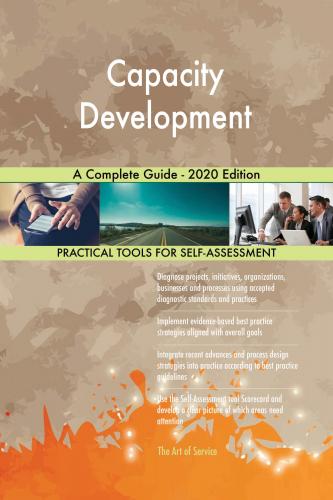47. How do you verify Capacity Development completeness and accuracy?
<--- Score
48. When should you bother with diagrams?
<--- Score
49. Are supply costs steady or fluctuating?
<--- Score
50. Do the benefits outweigh the costs?
<--- Score
51. What are the strategic priorities for this year?
<--- Score
52. How frequently do you verify your Capacity Development strategy?
<--- Score
53. Have design-to-cost goals been established?
<--- Score
54. Have you made assumptions about the shape of the future, particularly its impact on your customers and competitors?
<--- Score
55. How will your organization measure success?
<--- Score
56. What does your operating model cost?
<--- Score
57. What drives O&M cost?
<--- Score
58. What methods are feasible and acceptable to estimate the impact of reforms?
<--- Score
59. What is the root cause(s) of the problem?
<--- Score
60. Are there sufficient policy analysis tools and capacity development to formulate the necessary environmental policies and programs?
<--- Score
61. What do people want to verify?
<--- Score
62. Was a life-cycle cost analysis performed?
<--- Score
63. What is measured? Why?
<--- Score
64. What are the costs of reform?
<--- Score
65. What are your primary costs, revenues, assets?
<--- Score
66. What is your Capacity Development quality cost segregation study?
<--- Score
67. What are your operating costs?
<--- Score
68. Will Capacity Development have an impact on current business continuity, disaster recovery processes and/or infrastructure?
<--- Score
69. What are you verifying?
<--- Score
70. How do you verify the Capacity Development requirements quality?
<--- Score
71. Are there competing Capacity Development priorities?
<--- Score
72. What disadvantage does this cause for the user?
<--- Score
73. When are costs are incurred?
<--- Score
74. What causes mismanagement?
<--- Score
75. Why do the measurements/indicators matter?
<--- Score
76. Is the cost worth the Capacity Development effort ?
<--- Score
77. What could cause delays in the schedule?
<--- Score
78. What do you measure and why?
<--- Score
79. How much does it cost?
<--- Score
80. What are the types and number of measures to use?
<--- Score
81. What are the estimated costs of proposed changes?
<--- Score
82. Do you aggressively reward and promote the people who have the biggest impact on creating excellent Capacity Development services/products?
<--- Score
83. Who pays the cost?
<--- Score
84. What are allowable costs?
<--- Score
85. How can you measure the performance?
<--- Score
86. How do you measure variability?
<--- Score
87. Who decides which capacity development responses to prioritize?
<--- Score
88. Who should receive measurement reports?
<--- Score
89. How will the Capacity Development data be analyzed?
<--- Score
90. Are you aware of what could cause a problem?
<--- Score
91. What does losing customers cost your organization?
<--- Score
92. What is the total fixed cost?
<--- Score
93. How can you measure Capacity Development in a systematic way?
<--- Score
94. What measurements are being captured?
<--- Score
95. What causes investor action?
<--- Score
96. How do you verify your resources?
<--- Score
97. Why do you expend time and effort to implement measurement, for whom?
<--- Score
98. How do you verify and develop ideas and innovations?
<--- Score
99. What are the costs and benefits?
<--- Score
100. What are predictive Capacity Development analytics?
<--- Score
101. Has a cost center been established?
<--- Score
102. Are missed Capacity Development opportunities costing your organization money?
<--- Score
103. What could cause you to change course?
<--- Score
104. What is your decision requirements diagram?
<--- Score
105. How will success or failure be measured?
<--- Score
106. How is progress measured?
<--- Score
107. How frequently do you track Capacity Development measures?
<--- Score
108. What measurements are possible, practicable and meaningful?
<--- Score
109.
